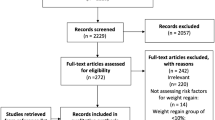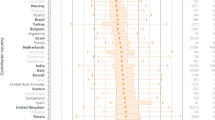Abstract
Background
The continuing need for simple, safe, and effective procedures led us to design a new operation for treating morbid obesity.
Methods
Thirty-two patients underwent our novel procedure, sleeve gastrectomy plus side-to-side jejunoileal anastomosis (SG plus), and were followed for 6 to 24 months. A matched cohort of 32 patients underwent sleeve gastrectomy over the same period and was used as the control group. Weight loss, comorbidity outcomes, and the duodenum to cecum transit time after a gastrografin swallow, performed at postoperative day 4, were compared.
Results
There were no deaths and no major perioperative complications. Three patients developed long-term complications requiring surgical intervention (intestinal obstruction, nausea–vomiting, and hypoalbuminemia). In the SG plus group, a 77.8 % excess weight loss was achieved at 12 months postoperatively, which was significantly better (p < 0.01) than the 67 % observed in the control group. The comorbidity outcomes, particularly diabetes resolution, were also significantly superior in the SG plus patients. The duodenum to cecum transit time of 11 min in the SG plus group was significantly shorter (p < 0.01) than the 31 min observed in the control group.
Conclusions
Sleeve gastrectomy plus side-to-side jejunoileal anastomosis appears to be a simple, considerably safe, and effective procedure for treating obesity and its metabolic comorbidities.

Similar content being viewed by others
References
Aggarwal S, Kini SU, Herron DM. Laparoscopic sleeve gastrectomy for morbid obesity: a review. Surg Obes Relat Dis. 2007;3:189–94.
Melissas J, Koukouraki S, Askoxylakis J, et al. Sleeve gastrectomy—a restrictive procedure? Obes Surg. 2007;17:57–62.
Murphy KG, Dhillo WS, Bloom SR. Gut peptides in the regulation of food intake and energy homeostasis. Endocr Rev. 2006;27:719–27.
Gallgher TK, Geoghegan JG, Baird AW, et al. Implications of altered gastrointestinal motility in obesity. Obes Surg. 2007;17:1399–407.
Rubino F, Zizzari P, Tomasetto C, et al. The role of the small bowel in the regulation of circulatin ghrelin levels and food intake in the obese Zucker rat. Endocrinology. 2005;16:1745–51.
Bose M, Olivan B, Teixeira J, et al. Do incretins play a role in the remission of type 2 diabetes after gastric bypass surgery: what are the evidence? Obes Surg. 2009;19:217–29.
Wren AM, Bloom SR. Gut hormones and appetite control. Gastroenterology. 2007;132:2116–30.
Strader AD, Torsten PV, Jandacek RJ, et al. Weight loss through ileal transposition is accompanied by increased ileal hormone secretion and synthesis in rats. Am J Physiol Endocrinol Metab. 2005;288:E447–53.
Santoro S, Malzoni CE, Velhote MCP, et al. Digestive adaptation with intestinal reserve: a neuroendocrine-based operation for morbid obesity. Obes Surg. 2006;16:1371–79.
De Paula AL, Macedo ALV, Rassi N, et al. Laparoscopic treatment for type 2 diabetes mellitus for patients with a body mass index less than 35. Surg Endosc. 2008;22:706–16.
Boza C, Gagner M, Devaud N, et al. Laparoscopic sleeve gastrectomy with ileal transposition (SGIT): a new surgical procedure as effective as gastric bypass for weight control in a porcine model. Surg Endosc. 2008;22:1029–34.
De Paula AL, Macedo ALV, Prudente AS, et al. Laparoscopic sleeve gastrectomy with ileal interposition (“neuroendocrine brake”)—pilot study of a new operation. Surg Obes Relat Dis. 2006;2:464–7.
Braghetto I, Davanzo C, Korn O, et al. Scintigraphic evaluation of gastric emptying in obese patients submitted to sleeve gastrectomy compared to normal subjects. Obes Surg. 2009;19:1515–21.
Melissas J, Daskalakis M, Koukouraki S, et al. Sleeve gastrectomy—a “food limiting” operation. Obes Surg. 2008;18:1251–56.
le Roux CW, Aylwin SJB, Batterham RL, et al. Gut hormone profiles following bariatric surgery favor an anorectic state, facilitate weight loss and improve metabolic parameters. Ann Surg. 2006;243:108–14.
Conflict of interest
All authors declare to have no conflict of interest.
Author information
Authors and Affiliations
Corresponding author
Additional information
John Melissas and Anastasia Peppe contributed equally to this work.
Rights and permissions
About this article
Cite this article
Melissas, J., Peppe, A., Askoxilakis, J. et al. Sleeve Gastrectomy Plus Side-to-Side Jejunoileal Anastomosis for the Treatment of Morbid Obesity and Metabolic Diseases: a Promising Operation. OBES SURG 22, 1104–1109 (2012). https://doi.org/10.1007/s11695-012-0637-9
Published:
Issue Date:
DOI: https://doi.org/10.1007/s11695-012-0637-9




